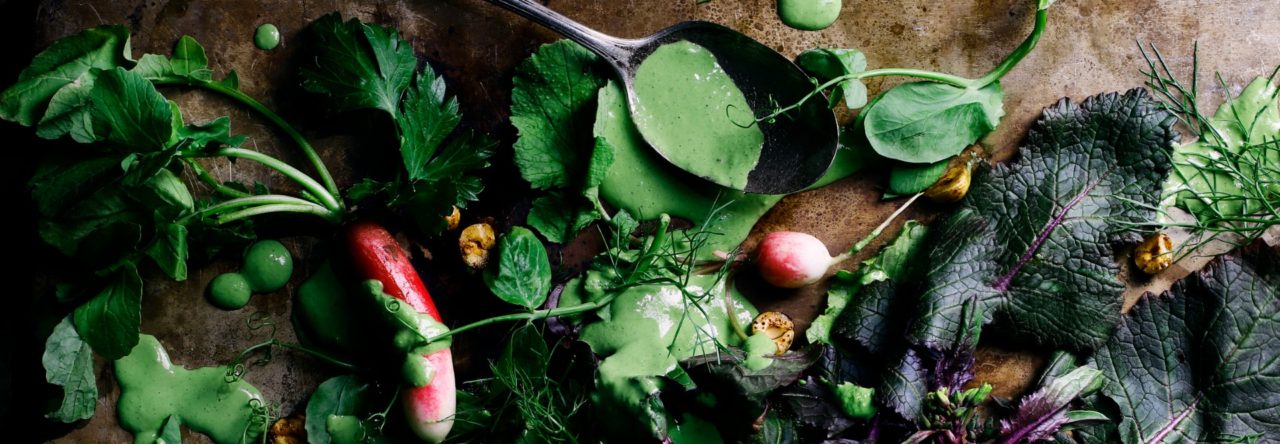Artichoke Skillet Paella with Chorizo Tempeh Crumbles
Serves 4 to 6
Paella is a famous Spanish dish, a massive pan of almost creamy, delicately seasoned saffron rice studded with all manner of toppings. Sometimes paella can seem an intimidating affair with all those extraneous toppings, but this vegan adaptation is far easier to put together sans the seafood and animal products, and the chorizo crumbles can be made well in advance. The other culprit in making paella seem more complex than it actually is the notion that a special pan and an open fire is required; a deep 12 inch skillet and your stovetop are the hardworking paella tools you already own (at least the stove part I hope). It’s important though you do use a skillet that’s at least that wide and no shallower than 2 inches. Paella is a bountiful dish, an ideal reason to gather the tribe for a relaxing weekend supper.
Ingredient tip:
Paella needs a starchy, short grain white rice to do its thing; Spanish Valencia (Bomba is best) is the classic rice for paella but probably one of the more difficult rice varieties to find. Italian arborrio rice is often used as a substitute too; the results will be soft and creamier than Spanish short grain but still tasty. In a pinch Japanese short grain sushi rice makes an okay stand-in, though stickier than the other rice, it cooks up chewy and creamy in the paella stock.
If you’d rather use purchased vegan chorizo for the paella for a faster dish, look for firm, sliceable sausage (Field Roast makes the tastiest and easiest to use chorizo) and avoid the squishy, greasy varieties. Or use your favorite spicy sausage links. For the best flavor, sauté thin slices of sausages for 1 to 2 minutes to lightly brown the exterior before using in the paella.
1 recipe Tempeh Chorizo Crumbles
4 tablespoons olive oil
10 ounce jar artichoke hearts, well drained or frozen, thawed and drained
1 large yellow onion, peeled and finely diced
6 cloves garlic, peeled and minced
2 red or yellow bell peppers (or one of each), core and seeds removed and diced into 1/2 inch pieces
1/3 cup dry white wine
2 cups short grain white rice such as Spanish Valencia, Italian Arrborio or Japanese sushi rice, rinsed and drained (see Japanese rice page XX for washing method)
4 cups vegetable broth (golden “chicken” flavor is recommended)
4 red ripe plum tomatoes, seeded and finely diced or 1 cup canned diced tomatoes
Generous pinch saffron threads (about 1/4 teaspoon), crushed
1 1/2 teaspoons dried thyme
3/4 teaspoon sea salt
1/2 teaspoon sweet or hot smoked paprika
1/2 teaspoon ground cumin
2 bay leaves
1 1/2 cups frozen green peas
½ cup frozen or jarred and drained pearl onions
2 tablespoons lemon juice
½ cup chopped parsley
1. Heat 1 tablespoon of the oil in 2 inch deep, 12 inch wide skillet. Slice the artichoke hearts into quarters and use a paper towel to pat away any moister. Add the artichokes to the pan and fry, stirring occasionally, for about 4 minutes or until the edges are browned. Transfer artichokes to a plate and set aside.
2. Add the remaining oil, then stir in the onion and fry for 4 minutes. Stir in the chopped bell peppers and fry another 5 minutes, then stir in wine and simmer for 2 minutes. Add the rice and fry, stirring occasionally, for 2 minutes.
3. Stir in 4 cups of the vegetable broth, the tomatoes, saffron, thyme, salt, paprika, cumin, and bay leaves. Increase heat to high and bring to a rolling boil, then reduce heat to low. This is important: do NOT cover the pan. Gently tuck the artichokes into the rice. Simmer the rice on low heat for 18 to 20 minutes and do not stir. Occasionally rotate the pan about 45 degrees on the top of the stove to help evenly distribute the heat throughout the rice as it cooks.
4. Around 18 minutes the rice should be mostly tender and almost all of the liquid should be absorbed with some thick liquid bubbling around the edges and spaces between the rice. If the rice still has crunchy cores and most of the liquid has been absorbed, add another 1/2 cup of vegetable broth and continue to simmer for another 5 minutes; if the rice has enough of moisture, don’t add additional broth but continue to simmer.
5. When the rice is very tender, the inner layer of rice is creamy and the liquid has been absorbed, sprinkle the top of the rice with the Tempeh Chorizo, lemon juice, the peas, and pearl onions. Partially cover the skillet and cook for 3 minutes. Remove the lid and gently stir the top of the rice with a fork; if a thin browned crust forms on the bottom of the paella, congradulation, you’ve just made soccorat, the much sought after bottom crust of a well made paella. If not and you’d like some crust, increase the heat to medium low and continue to cook uncovered for about another 3 to 5 minutes. Remove the bay leaves, sprinkle with parsley and serve the paella hot with lemon wedges for drizzling.
Chorizo Tempeh Crumbles
8 ounce package tempeh
2 tablespoons peanut oil
1 ¼ cups vegetable broth
3 cloves garlic, grated or ground into a paste in a mortar and pestle (see page XX)
3 tablespoons soy sauce
2 tablespoons tomato paste
2 teaspoons smoked sweet or hot paprika
1 1/2 teaspoons Mexican chile powder
½ teaspoon liquid smoke
1. Dice the tempeh into 1/2 inch chunks. In large skillet, preheat the peanut oil over medium heat. Stir in the tempeh and fry for 3 minutes or until the edges of the tempeh are lightly browned.
2. In a 2 cup liquid measuring cup whisk together the remaining ingredients. Pour into the skillet, increase the heat to medium high and bring the liquid to a rapid simmer. Cover the pan and simmer for 5 minutes. Uncover the pan and continue to simmer the tempeh, stirring occasionally, for another 5 to 8 minutes. Depending on how saucy you prefer the chorizo tempeh, serve it when it’s saucy and moist or continue to simmer until the liquid has been absorbed by the tempeh for drier crumbles.








